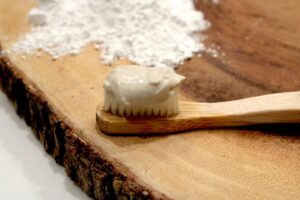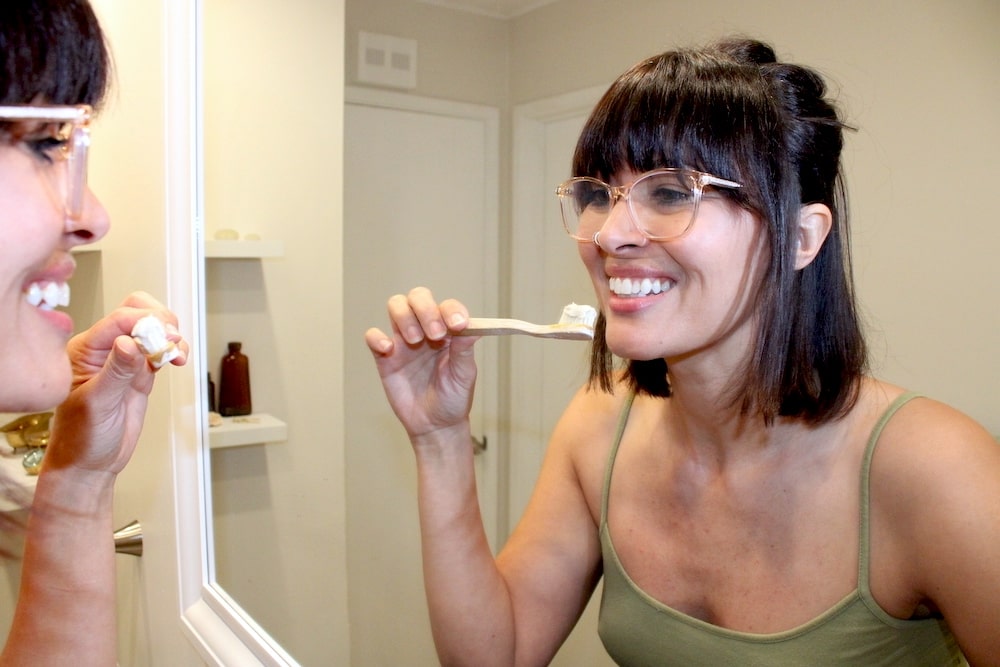Toothpaste is a non-negotiable.
You might choose not to wash your hair every day (a good idea) or not to get your nails done, but effective toothpaste is a necessity.
There are a lot of obvious reasons why a healthy mouth is a good thing. A nice smile enhances a face. Teeth are helpful for chewing delicious food. Bad breath scares people.
But science is also discovering it’s more complicated than we initially thought. It turns out that what’s going on inside your mouth drastically affects the rest of your body.
Take me straight to the recipe.
ORAL HEALTH IS OVERALL HEALTH
Research on the relationship between oral health and overall health has gained momentum in the last two decades.
Study after study shows that poor oral health can lead to serious medical conditions. Dental diseases like gingivitis and periodontitis are linked to heart disease, stroke, diabetes, osteoporosis, and arthritis.
Gingivitis and periodontitis are linked to heart disease, stroke, diabetes, osteoporosis, and arthritis.
This isn’t just about having a pretty smile anymore. Proper dental hygiene is now recognized as an essential part of maintaining a healthy body.
WHY BOTHER MAKING YOUR OWN
There are logical reasons why we trust big companies to create the most effective dental products. They have access to laboratories, scientists, and ingredients that aren’t available to the rest of us.
Unfortunately, these extra resources don’t always amount to a superior product.
In fact, there is plenty of scientific literature (and lawsuits) to prove that conventional toothpaste companies don’t really give a shit about our well-being.
Focusing on the naughty behavior of toothpaste companies might not be the path to enlightenment. But it is helpful to consider why we’d make our own toothpaste when there are plenty of affordable options.
MAKING YOUR OWN STUFF
It can be intimidating to make homemade stuff. Most of us are not overly confident in our ability to create an effective product. And, realistically, serious problems can occur if we’re haphazardly concocting things without doing the necessary research.
But the reputable companies we rely on for safe products mess up too. Like when they put triclosan in toothpaste and then triclosan was banned by the FDA. Or when they put polyethylene microbeads in toothpaste and then polyethylene microbeads were banned by the FDA. So, no one’s perfect.
And while we may not have access to fancy microscopes and laboratories, we do have access to the same professionals who inform those big companies.
We now have access to the same professionals who inform big toothpaste companies.
Sites like PubMed, Semantic Scholar, and Science Direct allow anyone to search through millions of peer-reviewed medical articles. That scientifically verified data can help us figure out which ingredients are actually useful.
TOOTHPASTE INGREDIENTS
Everything in a homemade product should serve a purpose. Filler ingredients are helpful for companies looking to turn a profit because it creates more product for a cheaper price. DIY versions gain nothing from unnecessary add-ons, so it makes sense to keep it simple.
You can make a very effective toothpaste using a few inexpensive ingredients:
Each of these ingredients has specific attributes that make it a great addition to a dental care routine.
INGREDIENT EXPLANATIONS
KAOLIN CLAY
Let’s start with the basics. Or, in this case, the base of this toothpaste mix. Kaolin clay, also known as China clay, is a soft, white powder frequently used to make porcelain.
The applications for kaolin clay are pretty diverse. It can reduce surgical bleeding, add antimicrobial protection, inhibit Hepatitis C, bind medicine into tablets, and keep wine drinkable. Kaolin clay has been used in skincare products since humans decided that nice skin is a good thing.
That’s great and all, but we need to be sure kaolin clay is safe for our teeth.
Normally, the more abrasive toothpaste is, the better it is at cleaning. This is usually the trade-off. Scrub with something abrasive to get teeth clean and white, but risk damage to the teeth in the process.
Kaolin clay is an exception. Dental research shows that kaolin clay has “high PCR [Pellicle Cleaning Ratio] scores and low RDA [Relative Dentin Abrasivity] values, resulting in higher CEI [Cleaning Efficiency Index] values.”
In English, please. Kaolin clay is really effective at cleaning teeth and removing stains without doing any damage. This is exactly what we want in toothpaste.
BAKING SODA
There is such a wide variety of uses for baking soda that most of us have this ingredient on hand. It also happens to be a fantastic addition to toothpaste.
Baking soda is mildly abrasive, so it helps clean teeth without damaging the enamel or dentin. A study in The Journal of The American Dental Association verified that “baking soda is a safe toothpaste ingredient and has a low abrasive potential in relation to dental surfaces.”
Besides its gentle cleaning power, baking soda is also antibacterial and alkaline. This helps balance oral pH and creates an inhospitable environment for destructive bacteria.
Xylitol
Sugar substitutes have been a thing for a while now. We want stuff to be sweet but not make us sick or fat. Is that too much to ask?
The quest for natural alternatives has certain sugar substitutes trending. And Xylitol might be at the top of that list. Xylitol is a naturally occurring sugar alcohol. It’s found in fruits and vegetables and can be extracted from various plants.
Xylitol has been widely studied over the last 40 years for its effect on dental health. It’s considered non-fermentable by oral bacteria. This means harmful bacteria in our mouths can’t convert xylitol to acid.
Although these bacteria can’t process xylitol for their fuel, they still ingest it. And once they’ve absorbed xylitol, they can’t absorb glucose. This causes the bacteria to starve to death.
That sounds super morose. I generally don’t like the idea of anything suffering. But these bacteria want to snack on our teeth until nothing remains but painful little stubs. So starve away.
But what about the good bacteria? Fortunately, multiple studies have shown that xylitol reduces cavity-causing bacteria without negatively affecting beneficial bacteria.
Additionally, xylitol acts as an anti-inflammatory to help prevent and treat periodontitis.
Xylitol kills bad bacteria, doesn’t hurt good bacteria, prevents cavities, reduces inflammation, and makes our homemade toothpaste taste delicious. That’s a sweet deal. Get it? Cause it’s a sugar substitute.
ESSENTIAL OIL
A variety of essential oils can be added to toothpaste. You just want to make sure it’s food-grade. If the bottle says, “not for internal use” you might not want to put it in your mouth.
I use peppermint oil. It’s inexpensive, thoroughly researched, and makes my mouth feel fresh and minty.
Studies have shown that peppermint oil offers antibacterial, antimicrobial, and antioxidant protection. It can also help to control bad breath and promote overall oral health.
WATER
This ingredient is negotiable. Adding water to anything increases the potential for things going bad. Typically, preservatives are added to commercial toothpaste –even the natural kind — to control the growth of microorganisms. But introducing preservatives comes with issues of its own.
WHY NOT COCONUT OIL
I’m entirely willing to wrestle anyone who talks smack about coconut oil.
I love coconut oil. The smell, the taste, and the staggering variety of uses. And there’s plenty of research to support its awesomeness. But, as the name indicts, it is an oil. And oil and plumbing are not a good mix. Over time, coconut oil will clog sink pipes.
Most people’s workaround is to spit oil-based toothpaste into the toilet. I am not a fan of this. Maybe it reminds me of the good ol’ college days and praying to the porcelain gods. Or maybe my teeth feel less clean after my face has been where butts go.
Either way, there are plenty of other natural ingredients that are great for teeth and don’t require hovering over a toilet.
Homemade TOOTHPASTE RECIPE
A Simple Toothpaste Without Coconut Oil
INGREDIENTS:
- 2 tsp kaolin clay*
- 1 tsp baking soda*
- 1 tsp xylitol*
- 3 drops of peppermint oil*
- 1 tsp water
Equipment:
- non-metallic bowl
- non-metallic spoon
- jar or squeeze bottle

INSTRUCTIONS:
- Combine the xylitol and peppermint oil in a small non-metal bowl and mix thoroughly.
- Using a wooden or plastic spoon stir in the kaolin clay and baking soda.
- Add the water and mix until the ingredients are well combined.
- Store the paste or powder in a small glass jar with a lid.
- Don’t stick your toothbrush directly into the paste.
TIPS AND TRICKS
These tips can improve your results when making your homemade toothpaste.
- Mix the peppermint oil and the xylitol first.
- This helps disperse the peppermint oil evenly so that you don’t have big clumps of alarming freshness. Added bonus, it smells like a delicious candy cane.
- Don’t use metal utensils or bowls for mixing or storing.
- Maybe this matters, maybe it doesn’t. The theory is that clays can leach metal ions from the metal spoons or bowls, and this will either ruins the clay’s benefits or will make the clay toxic. Honestly, I haven’t found much verifiable information on this topic. But it’s easy to be cautious and not use metal when working with this recipe.
- Make this as a powder rather than a paste for infinite shelf life.
- As mentioned earlier, adding water to the mix allows for the potential for microbial growth. But adding water also makes it feel more like toothpaste and less like you’re brushing your teeth with a blurring foundation. Try both versions and see what you prefer.
- Repurpose a small jar to hold the toothpowder. Or get a small squeeze bottle if you’re making a paste.
- If you’re using powder, tap the powder into the jar’s lid and stick your toothbrush only in the powder you’ll be using right away. Then you can rinse and dry the lid before putting it back on the jar. If you’re using paste, then you can use a small squeeze bottle as a makeshift toothpaste tube.
- Try not to stick your toothbrush directly into the paste or powder.
- I know this is hard. It’s way easier to just dunk your toothbrush into the mix. But toothbrush bristles are not pristine. Where do you think all that crap that came off your teeth went? Yeah, onto the bristles. So, don’t muck up your beautiful new product with months of tooth crude.
This recipe can be easily modified to suit sensitivities or preferences. None of the measurements are to be taken too seriously. Start with small batches, so you can adjust the quantities of the ingredients to your liking.
Making your own toothpaste is simple and has so many benefits.
There’s the perk of knowing precisely what’s going into your toothpaste and, consequently, into your body. You can modify the ingredients to your personal tastes and sensitivities. And you’ll also be saving money while minimizing plastic toothpaste tube waste.
Isn’t crafting your own products so satisfying?

I am going to try making this toothpaste. But I hate peppermint! UGH! Is spearmint oil or wintergreen oil okay? Thank you
Of course! You can use any tooth-safe oil you like. Both of the options you name should work great since they are often used for dental hygiene.
And you should keep writing! You’re good at it. I’m enjoying browsing your website and getting some great tips and laughs along the way.